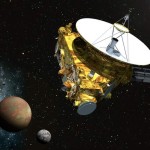Water and ice found
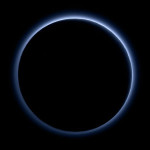 NASA says that Pluto has traces of water and ice on its surface. Red-colored frozen surface water is confirmed by combining spectral infrared and visible light data taken by two of New Horizons’ image sensors. The agency also releases a picture of Pluto’s blue sky, which is caused by tiny, sunlight-scattering particles in the atmosphere. Those particles probably begin as molecular nitrogen (which Pluto is constantly emitting) and other trace gases.
NASA says that Pluto has traces of water and ice on its surface. Red-colored frozen surface water is confirmed by combining spectral infrared and visible light data taken by two of New Horizons’ image sensors. The agency also releases a picture of Pluto’s blue sky, which is caused by tiny, sunlight-scattering particles in the atmosphere. Those particles probably begin as molecular nitrogen (which Pluto is constantly emitting) and other trace gases.
Charon detailed images
NASA releases detailed photos and a flyover animation of Charon, taken by New Horizons when it made its close flyby of Pluto on July 14. Scientists say they expected to find a long-dead world pocked with craters, but instead the surface plays host to mountains, a red north pole and a host of other geological features including a canyon more than 1,000 miles wide that stretches across the moon’s Pluto-facing side, and perhaps along the far-side of the world. That canyon is probably four times longer than the Grand Canyon is on Earth, and twice as deep in some places.
We thought the probability of seeing such interesting features on this satellite of a world at the far edge of our solar system was low, but [we] couldn’t be more delighted with what we see.
Pluto hi-resolution images
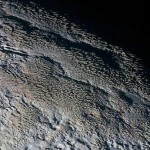 NASA releases high resolution New Horizons images of Pluto’s surface that show rippling terrain that stretches many hundreds of km. Team member:
NASA releases high resolution New Horizons images of Pluto’s surface that show rippling terrain that stretches many hundreds of km. Team member:
It looks more like tree bark or dragon scales than geology. This’ll really take time to figure out; maybe it’s some combination of internal tectonic forces and ice sublimation driven by Pluto’s faint sunlight.
The ripples are part of a 70MB image (link) that combines images from the probe’s Ralph/Multispectral Visual Imaging Camera, that combines blue, red and near infrared (NIR) images.
Tens of millions of Pluto pixels, in color. The highest-res enhanced-color view of Pluto yet. http://t.co/jSZ2Fqyo6q pic.twitter.com/VJUsoZwMlM
— Dr. Alex Parker (@Alex_Parker) September 24, 2015
Next flyby target selected
NASA determines the next likely target destination for a flyby by New Horizons, a small object in the Kuiper Belt called 2014MU69. It orbits almost a billion miles away from Pluto. A full proposal about the mission will be evaluated by NASA experts before the go ahead is officially given. NASA Science Mission Directorate Chief Grunsfeld:
Even as the New Horizon’s spacecraft speeds away from Pluto out into the Kuiper Belt, and the data from the exciting encounter with this new world is being streamed back to Earth, we are looking outward to the next destination for this intrepid explorer. While discussions whether to approve this extended mission will take place in the larger context of the planetary science portfolio, we expect it to be much less expensive than the prime mission while still providing new and exciting science.
NASA anticipates greater discoveries
Speaking before the House Committee on Science, Space and Technology, Stern says scientific information gleaned from the New Horizons mission to Pluto is “revolutionizing” what they know about the icy dwarf planet, predicting that even greater discoveries lay ahead.
With only 5% of data on the ground, we all feel we need to fasten our seat belts for the next 95%.
It will take 16 months for all the collected data from New Horizons to be transmitted to Earth. Scientists say the mission demonstrates this need for further planetary exploration.
Now is the time to accelerate, not curtail, the pace and scope of our nation’s solar system exploration program.
Heart shape sharper image
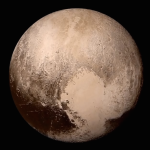 NASA releases a sharper image of Pluto showing that the left half of the Tombaugh Regio heart region is different than the right. The left half is more filled in. Scientists believe some process, possibly wind, is blowing material from the left half to the right half.
NASA releases a sharper image of Pluto showing that the left half of the Tombaugh Regio heart region is different than the right. The left half is more filled in. Scientists believe some process, possibly wind, is blowing material from the left half to the right half.
Our interpretation is that material in the right lobe — the source for that material — is coming from the western [or left] lobe.
Glaciers
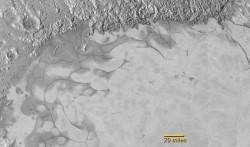 NASA releases a photo which suggests that glaciers are flowing on Pluto’s surface in the region of Sputnik Planum. Scientists believe the ice is made of nitrogen, carbon monoxide and methane.
NASA releases a photo which suggests that glaciers are flowing on Pluto’s surface in the region of Sputnik Planum. Scientists believe the ice is made of nitrogen, carbon monoxide and methane.
To see evidence of recent geological activity is simply a dream come true. The appearance of this terrain, the utter lack of impact craters on Sputnik Planum, tells us that this is really a young unit.
Eclipses the sun
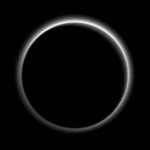 NASA releases a photo of Pluto eclipsing the sun showing a haze in Pluto’s atmosphere which extends at least 160 km (100 miles) above the surface.
NASA releases a photo of Pluto eclipsing the sun showing a haze in Pluto’s atmosphere which extends at least 160 km (100 miles) above the surface.
This is one of our first images of Pluto’s atmosphere. [It] stunned the encounter team. For 25 years, we’ve known that Pluto has an atmosphere. But it’s been known by numbers. This is our first picture. This is the first time we’ve really seen it. This was the image that almost brought tears to the eyes of the atmospheric scientists on our team.
Pluto and Charon’s natural color
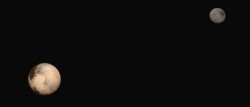 NASA releases this photo which shows Pluto’s reddish color and Charon’s gray tone. Scientists think Pluto’s red color is the result of particles created in its atmosphere, through methane’s interaction with UV light. The particles stick together, growing heavier, and eventually rain down on the surface. Observations show that Charon does not have much of an atmosphere.
NASA releases this photo which shows Pluto’s reddish color and Charon’s gray tone. Scientists think Pluto’s red color is the result of particles created in its atmosphere, through methane’s interaction with UV light. The particles stick together, growing heavier, and eventually rain down on the surface. Observations show that Charon does not have much of an atmosphere.
For now, all that we can say is, it’s a much more rarefied atmosphere [than Pluto’s]. It may be that there’s a thin nitrogen layer in the atmosphere, or methane, or some other constituent. But it must be very tenuous compared to Pluto — again, emphasizing just how different these two objects are despite their close association in space.
Discovers second mountain range
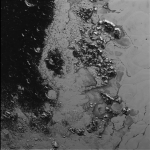 NASA releases a photo showing another mountain range on the lower left edge of Pluto’s heart-shaped region. The peaks are about 1 to 1.5 km (0.5 to 1 mile) high, about the size of the Appalachians. The new range is just west of the region within Pluto’s heart called Sputnik Planum (Sputnik Plain) and some 110 km (68 miles) northwest of Norgay Montes. This newest image further illustrates the remarkably well-defined topography along the western edge of Tombaugh Regio.
NASA releases a photo showing another mountain range on the lower left edge of Pluto’s heart-shaped region. The peaks are about 1 to 1.5 km (0.5 to 1 mile) high, about the size of the Appalachians. The new range is just west of the region within Pluto’s heart called Sputnik Planum (Sputnik Plain) and some 110 km (68 miles) northwest of Norgay Montes. This newest image further illustrates the remarkably well-defined topography along the western edge of Tombaugh Regio.
There is a pronounced difference in texture between the younger, frozen plains to the east and the dark, heavily-cratered terrain to the west. There’s a complex interaction going on between the bright and the dark materials that we’re still trying to understand.
Nix and Hydra
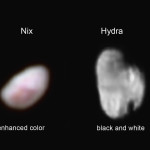 NASA releases photos of Pluto’s moons Nix and Hydra. Nix is about 42 km (26 miles) long and 36 km (22 miles) wide. Nix’s surface is a light gray with an area that is light red which scientists think might be a crater. Hydra is about 55 km (34 miles) long and 40 km (25 miles) wide and has at least two large craters.
NASA releases photos of Pluto’s moons Nix and Hydra. Nix is about 42 km (26 miles) long and 36 km (22 miles) wide. Nix’s surface is a light gray with an area that is light red which scientists think might be a crater. Hydra is about 55 km (34 miles) long and 40 km (25 miles) wide and has at least two large craters.
Before last week, Hydra was just a faint point of light, so it’s a surreal experience to see it become an actual place, as we see its shape and spot recognizable features on its surface for the first time.
Frozen plains
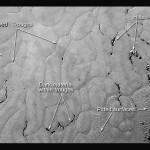 NASA releases a close-up photo of an area in the center-left of the heart feature of a young craterless plain which they name Sputnik Planum. It has a broken surface of irregularly-shaped segments, roughly 20 km (12 miles) across, bordered by what appear to be shallow troughs, some of which have darker material within them, while others are traced by clumps of hills that appear to rise above the surrounding terrain. Elsewhere, the surface appears to be etched by fields of small pits that may have formed by sublimation.
NASA releases a close-up photo of an area in the center-left of the heart feature of a young craterless plain which they name Sputnik Planum. It has a broken surface of irregularly-shaped segments, roughly 20 km (12 miles) across, bordered by what appear to be shallow troughs, some of which have darker material within them, while others are traced by clumps of hills that appear to rise above the surrounding terrain. Elsewhere, the surface appears to be etched by fields of small pits that may have formed by sublimation.
This terrain is not easy to explain. The discovery of vast, craterless, very young plains on Pluto exceeds all pre-flyby expectations.
Flyover animation
NASA releases a flyover animation over part of Tombaugh Regio, the heart-shaped area of Pluto, and the Norgay Montes mountains, which are named for Tenzing Norgay, the sherpa who accompanied Edmund Hillary on the first successful ascent of Mt. Everest. The animation is created from images taken by the Long Range Reconnaissance Imager (LORRI) on the New Horizons probe during the Pluto flyby on July 14, 2015. Using photographs taken from just 77,000 kilometers (48,000 miles) away from the surface, the resolution is good enough that features as small as a kilometers across (0.5 miles) are visible.
Charon mountain
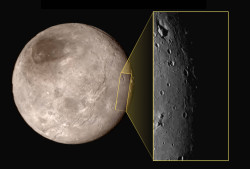 NASA shares a close-up photo of Pluto’s moon Charon showing a large mountain in a deep depression that is puzzling scientists.
NASA shares a close-up photo of Pluto’s moon Charon showing a large mountain in a deep depression that is puzzling scientists.
The most intriguing feature is a large mountain sitting in a moat. This is a feature that has geologists stunned and stumped. It looks like someone just dropped a giant boulder on Charon.
Different ices
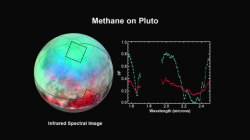 The New Horizons team release a composite photo showing different methane ice accumulations over Pluto’s surface. The photo is compiled using RALPH’s 256 infrared wavelengths overlaying a LORRI basemap.
The New Horizons team release a composite photo showing different methane ice accumulations over Pluto’s surface. The photo is compiled using RALPH’s 256 infrared wavelengths overlaying a LORRI basemap.
All I’m showing is the diversity of terrains. The ices do have distinct properties, different melting points.
Heart-shaped area named after Tombaugh
Scientists name Pluto’s newly-discovered heart-shaped region Tombaugh Regio, after Tombaugh, who discovered the planet in 1930.
Discovers ice mountains
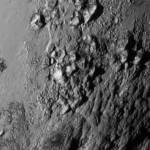 Scientists share the first high-resolution images of Pluto’s surface taken by New Horizons, showing ice mountains 11,000 ft high. Pluto’s thin coating of methane, carbon monoxide and nitrogen ice on Pluto’s surface was not strong enough to form mountains — the scientist believe they are probably composed of Pluto’s water-ice bedrock
Scientists share the first high-resolution images of Pluto’s surface taken by New Horizons, showing ice mountains 11,000 ft high. Pluto’s thin coating of methane, carbon monoxide and nitrogen ice on Pluto’s surface was not strong enough to form mountains — the scientist believe they are probably composed of Pluto’s water-ice bedrock
Mission scientists say the image show a terrain that had been resurfaced by some geological process – such as volcanism – within the last 100 million years.
We have not found a single impact crater on this image. This means it must be a very young surface.
This active geology needs some source of heat. Previously, such activity has only been seen on icy moons, where it can be explained by “tidal heating” caused by gravitational interactions with a large host planet.
You do not need tidal heating to power geological activity on icy worlds. That’s a really important discovery we just made this morning.
Color photos
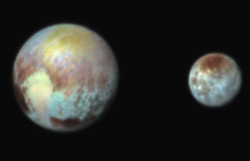 NASA releases color images of Pluto and Charon. The heart shape on Pluto is different colors indicating different geologic, tectonic, or morphological origins. The big red spot near Charon’s north polar region are most likely nitrogen particles from Pluto. The sun burns off the particles on the areas facing the sun, but not the polar region which faces away from the sun for decades.
NASA releases color images of Pluto and Charon. The heart shape on Pluto is different colors indicating different geologic, tectonic, or morphological origins. The big red spot near Charon’s north polar region are most likely nitrogen particles from Pluto. The sun burns off the particles on the areas facing the sun, but not the polar region which faces away from the sun for decades.
Some regions are relatively ancient, and other places are very young and currently undergoing geologic evolution.
Closest approach
After flying three billion miles from Earth, at 7:49 a.m. EDT, New Horizons makes its closest approach to Pluto at 7,700 miles from the surface. It flies past at 31,000 mph. The team receives confirmation from the spacecraft around 9:00 p.m. EDT that the flyby is a success.
Hey, people of the world! Are you paying attention? We have reached Pluto. We are exploring the hinterlands of the solar system. Rejoice!
Heart shape closeup
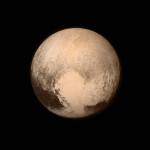 New Horizons takes a photo of Pluto from 768,000 km (476,000 miles) away showing a close-up view of the heart-shaped feature. The heart measures about 1,600 km (1,000 miles) across. The heart borders darker equatorial terrains, and the mottled terrain to its east (right) are complex. However, even at this resolution, much of the heart’s interior appears remarkably featureless—possibly a sign of ongoing geologic processes.
New Horizons takes a photo of Pluto from 768,000 km (476,000 miles) away showing a close-up view of the heart-shaped feature. The heart measures about 1,600 km (1,000 miles) across. The heart borders darker equatorial terrains, and the mottled terrain to its east (right) are complex. However, even at this resolution, much of the heart’s interior appears remarkably featureless—possibly a sign of ongoing geologic processes.
Wow! My prediction was that we would find something wonderful, and we did. This is proof that good things really do come in small packages.
